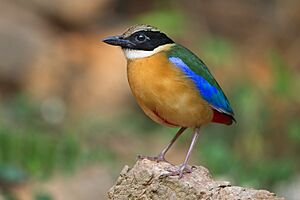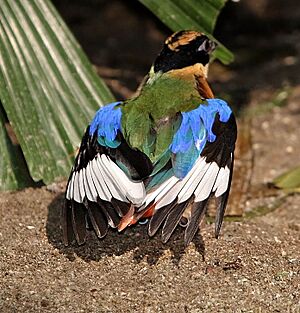Blue-winged pitta facts for kids
Quick facts for kids Blue-winged pitta |
|
|---|---|
 |
|
| Conservation status | |
| Scientific classification | |
| Genus: |
Pitta
|
| Species: |
moluccensis
|
The blue-winged pitta (Pitta moluccensis) is a beautiful, colorful bird. It belongs to the pitta family and is known for its bright feathers. This bird is closely related to three other pitta species: the Indian pitta, the fairy pitta, and the mangrove pitta.
Blue-winged pittas have a black head with a light stripe above their eyes. They also have a white collar, green upper parts, and bright blue wings. Their underside is a light buff color, and they have a reddish area near their tail. You can find these birds in many parts of Asia. Their home stretches from India to Malaysia, Indonesia, southern China, and the Philippines. They prefer living in damp woodlands, parks, and gardens. However, they usually stay away from very thick forests. These birds mostly eat insects and worms. In the spring, they build a round, somewhat messy nest on the ground. This nest is often found near water or between tree roots. Both parents help to hatch about five eggs, which usually takes around sixteen days.
Contents
About the Blue-winged Pitta
What's in a Name?
The blue-winged pitta was first described in 1776 by a German scientist named Philipp Ludwig Statius Müller. He gave it the scientific name Turdus moluccensis. This name came from a picture of a bird called the "Merle des Moluques." The name moluccensis refers to the Moluccas, which are islands. However, this was a mistake! The blue-winged pitta doesn't actually live that far east. Later, in 1963, its official home was changed to Malacca in Malaysia.
Today, this bird is placed in the Pitta group. This group was named by a French bird expert, Louis Pierre Vieillot, in 1816. The blue-winged pitta is the only bird of its kind within its species.
Family Ties: The Superspecies
The blue-winged pitta is part of a "superspecies" group. This means it's very closely related to the Indian pitta, fairy pitta, and mangrove pitta. They share many similar features. People also call this bird by other names, like the lesser blue-winged pitta or the Moluccan pitta.
What Does a Blue-winged Pitta Look Like?
The blue-winged pitta is about 18 to 20.5 centimeters (7 to 8 inches) long. It has a black head with a light, buff-colored stripe above its eye. Its chin is white, and its belly is buff. The bird's shoulders and back are greenish, and its wings are a bright blue. The area under its tail is reddish.
This bird has a black beak, brown eyes, and pale pink legs. It also has a very short tail. Young blue-winged pittas look similar to adults, but their colors are not as bright. This bird looks a lot like the mangrove pitta. However, you can tell them apart because the blue-winged pitta has a shorter beak. When it calls, it makes a loud sound that sounds like taew-laew taew-laew.
Where Do Blue-winged Pittas Live?
Blue-winged pittas are commonly found in many countries. These include Brunei, Cambodia, China, India, Indonesia, Laos, Malaysia, Myanmar, the Philippines, Singapore, Thailand, and Vietnam. Sometimes, they are also seen in places like Australia, Christmas Island, Taiwan, and Hong Kong.
These birds live in different types of places, up to 800 meters (2,600 feet) high. They can be found in broad-leaved forests, parks, gardens, and even mangrove areas. But they tend to stay away from very dense rainforests.
Their main home is across much of Southeast Asia and Indochina. This includes central Myanmar, east through Thailand, and into Malaysia. Some blue-winged pittas visit Borneo and Sumatra during the winter. They are also sometimes seen in the Philippines and Java. It's very rare to spot them on the northwestern coast of Australia.
What Do Blue-winged Pittas Eat?
Blue-winged pittas mostly eat worms and insects. They hunt for their food on the ground or from a low branch. They also enjoy eating snails with hard shells.
How Do Blue-winged Pittas Raise Their Young?
When it's time to have babies, the blue-winged pitta builds a large nest. It's usually built on the ground and made from twigs, roots, grasses, leaves, and moss. The nest is round and can look a bit messy. It has an entrance on the side. You can often find these nests between tree roots, especially near water.
In Malaysia, where they breed, blue-winged pittas lay their eggs between early May and late July each year. The female bird lays about 4 to 6 eggs. These eggs are white or cream-colored with purple marks. Both parents take turns sitting on the eggs to keep them warm. This incubation period lasts for about 15 to 17 days until the eggs hatch.



